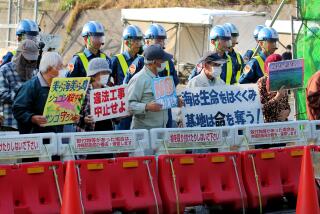Tokyo Plagued by 25-Year-Old Airport Dispute : Aviation: Naritaâs expansion is stymied by farmers and radicals. New Osaka facility is also having problems.
TOKYO â Japanâs capital has been saddled for years with an airport so crowded that some airlines rate it worse than many in the Third World.
It is the only international airport serving the worldâs most populous metropolitan area and one of only three international airports in the fast-growing nation of about 124 million people.
Eight farmers who refuse to sell their land are a major reason that work cannot go forward on planned construction, estimated to cost as much as $12 billion, of two new runways and a second terminal building at New Tokyo International Airport, better known as Narita.
Meanwhile, at Osaka, almost 300 miles southwest of Tokyo, work on a $9-billion second international airport being built on an artificial island is a year behind schedule and running into all kinds of problems.
Kakichi Ogawa is one of the farmers who refuses to move out to make way for construction at New Tokyo International, one of the worldâs busiest airports. It operates at maximum capacity, with a plane landing or taking off every two minutes on its single runway.
âIâm trying to protect democracy,â says Ogawa, 67. âPeople should protect their rights. We canât let our laws be chased away by money.â
He and the seven other farmers, along with numerous left-wing radicals who have espoused the farmersâ cause, complain that they have been lied to and bullied by Japanese authorities.
At the Transport Ministry, Masafusa Shiokawa of the Civil Aviation Bureau sees the situation differently.
âPerhaps some farmers donât want to part with their land,â he says, âbut the main problem is the radicals. They have agitated the farmers. The government canât deal with such people.â
In the nearly 25 years that the dispute has dragged on, more than 3,000 activists have been arrested in clashes with police at airport construction sites. Three policemen and two protesters have been killed.
Attempts to expropriate the land through legal channels have been thwarted by a series of terrorist attacks on the homes of public officials. Very few in the government are now willing to act on the issue.
New Tokyo International Airport, about 30 miles from the capital in the town of Narita, opened in 1978. It was designed to replace Tokyo International Airport at Haneda, which today is used mostly for domestic flights.
The Narita facility now handles more than 60,000 passengers and 4,000 tons of cargo every day--a feat made all the more remarkable by the fact that the airport has been confined to only about 1,300 acres.
When plans for New Tokyo International were drawn up in the 1960s, the facility was intended to sprawl over more than 2,600 acres, with three runways.
Authorities are arranging a symposium to discuss the airport dispute with farmers and with nearly 1,300 of the farmersâ sympathizers who have purchased small parcels of land in the area.
âThe solution is to talk directly to the farmers and try to find answers,â Shiokawa says. âWe must separate the farmers from the radicals. The climate is improving. Soon we will be able to reach a compromise and buy the land.â
As all this simmers on in Tokyo, work is progressing on the massive project to build Kansai International Airport on an artificial island 3 miles offshore in Osaka Bay.
The project, plagued by cost overruns, bidding disputes and technical glitches, is now more than a year behind schedule. If all goes well from now on, the new facility should open in the summer of 1994. It will be Japanâs first and only 24-hour airport.
âThere are no problems,â says an optimistic Kiyoshi Hoji, the Transport Ministryâs man at Kansai. âThe land is sinking and the terminal is a little too big, but we can deal with this.â
What Hoji dismisses as a minor setback is in fact a major headache for the airportâs developers. The surface of the artificial island is subsiding at a far faster pace than expected, requiring an extra 50 million cubic feet of soil to be shipped hurriedly from the mainland.
When construction began, water was drained from the site and sand was driven into the clay seabed to strengthen the foundation. Nearly 12 miles of seawalls were then installed to form the islandâs rectangular perimeter, and almost 500 million cubic feet of soil was dumped into the center.
That much dirt would be enough to raise the entire island of Manhattan in New York more than 10 inches.
More to Read
Sign up for Essential California
The most important California stories and recommendations in your inbox every morning.
You may occasionally receive promotional content from the Los Angeles Times.











